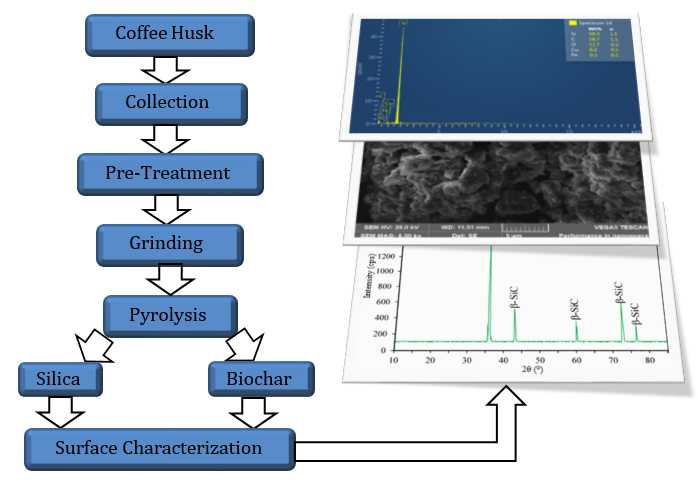[1]. Y. Gong, S. Qu, Y. Yang, C. Liang, P. Li, Y. She, Some observations in grinding SiC and silicon carbide ceramic matrix composite material,
The International Journal of Advanced Manufacturing Technology,
2019,
103, 3175-3186. [
Crossref], [
Google Scholar], [
Publisher]
[2]. K.W. Mas’udah, M. Diantoro, A. Fuad, Synthesis and structural analysis of silicon carbide from silica rice husk and activated carbon using solid-state reaction,
Journal of Physics: Conference Series, IOP Publishing,
2018, 012033. [
Crossref], [
Google Scholar], [
Publisher]
[3]. M. Pereira, D. Figueira, B. Girolamo, F. Vernilli, Synthesis of silicon carbide from rice husk,
Cerâmica,
2020,
66, 256-261. [
Crossref], [
Google Scholar], [
Publisher]
[4]. Y. Xie, Z. Huang, Q. Ni, S. Wang, L. Ban, T. Yun, J. Dai, L. Wang, X. Song, Synthesis of silicon carbide nanoplates by using laboratory wastes as resource at low temperature,
Journal of the Ceramic Society of Japan,
2022,
130, 943-947. [
Crossref], [
Google Scholar], [
Publisher]
[5]. M. Dasog, L.F. Smith, T.K. Purkait, J.G. Veinot, Low temperature synthesis of silicon carbide nanomaterials using a solid-state method,
Chemical Communications,
2013,
49, 7004-7006. [
Crossref], [
Google Scholar], [
Publisher]
[6]. L. Carassiti, A. Jones, P. Harrison, P.S. Dobson, S. Kingman, I. MacLaren, D.H. Gregory, Ultra-rapid, sustainable and selective synthesis of silicon carbide powders and nanomaterials via microwave heating,
Energy & Environmental Science,
2011,
4, 1503-1510. [
Crossref], [
Google Scholar], [
Publisher]
[7]. A. Najafi, F.G. Fard, H. Rezaie, N. Ehsani, Synthesis and characterization of SiC nano powder with low residual carbon processed by sol–gel method,
Powder Technology,
2012,
219, 202-210. [
Crossref], [
Google Scholar], [
Publisher]
[8]. H.X. Li, G.Y. Li, T.J. Hu, X.D. Li, Y.Q. Yang, Preparation of amorphous silicon carbide nanostructures via solvothermal method,
Applied Mechanics and Materials,
2014,
597, 49-52. [
Crossref], [
Google Scholar], [
Publisher]
[9]. Q. Wu, S. Yu, H. Zhong, X. Li, T. Xiao, L. Liu, X. Guo, Y. Li, Y. Nie, Preparation of silicon carbide coating by chemical vapor deposition by using hexamethyldisilylamine precursor,
Surface and Coatings Technology,
2018,
334, 78-83. [
Crossref], [
Google Scholar], [
Publisher]
[10]. A.Y. Pak, K. Larionov, A. Korchagina, T.Y. Yakich, A.Y. Nalivaiko, A. Gromov, Silicon carbide obtaining with DC arc-discharge plasma: synthesis, product characterization and purification,
Materials Chemistry and Physics,
2021,
271, 124938. [
Crossref], [
Google Scholar], [
Publisher]
[11]. S. Maroufi, M. Mayyas, V. Sahajwalla, Novel synthesis of silicon carbide nanowires from e-waste,
ACS Sustainable Chemistry & Engineering,
2017,
5, 4171-4178. [
Crossref], [
Google Scholar], [
Publisher]
[12]. S. Ndung’u, R. Wanjau, E. Nthiga, Efficacy of adsorption of congo red dyes from an aqueous media using silicon nitride (Si
3N
4) adsorbent derived from sand and coffee husk wastes. Eurasian,
Eurasian Journal of Science and Technology,
2024,
4, 253. [
Crossref], [
Google Scholar], [
Publisher]
[13]. R. Rajarao, R. Ferreira, S.H.F. Sadi, R. Khanna, V. Sahajwalla, Synthesis of silicon carbide nanoparticles by using electronic waste as a carbon source,
Materials Letters,
2014,
120, 65-68. [
Crossref], [
Google Scholar], [
Publisher]
[14]. S. Maroufi, M. Mayyas, R.K. Nekouei, M. Assefi, V. Sahajwalla, Thermal nanowiring of e-waste: a sustainable route for synthesizing green Si
3N
4 nanowires,
ACS Sustainable Chemistry & Engineering,
2018,
6, 3765-3772. [
Crossref], [
Google Scholar], [
Publisher]
[15]. S. Qadri, E. Gorzkowski, B. Rath, J. Feng, S. Qadri, H. Kim, J. Caldwell, M. Imam, Nanoparticles and nanorods of silicon carbide from the residues of corn,
Journal of Applied Physics,
2015,
117. [
Crossref], [
Google Scholar], [
Publisher]
[16]. Z. An, J. Xue, H. Cao, C. Zhu, H. Wang, A facile synthesis of silicon carbide nanoparticles with high specific surface area by using corn cob,
Advanced Powder Technology,
2019,
30, 164-169. [
Crossref], [
Google Scholar], [
Publisher]
[17]. R.R. Ravindra Rajarao, V.S. Veena Sahajwalla, A cleaner, sustainable approach for synthesising high purity silicon carbide and silicon nitride nanopowders using macadamia shell waste,
Journal of Cleaner Production,
2016, 133, 1277-1282. [
Crossref], [
Google Scholar], [
Publisher]
[18]. S. Ndung'u, E.W. Nthiga, R. Wanjau, Facile extraction and characterization of silica nanopowder from marine national park beach sand via alkali fusion route,
International Journal of Technology, 2023,
13, 1-6. [
Crossref], [
Google Scholar], [
Publisher]
[19]. S.N. Ndung'u, E.W. Nthiga, R. Wanjau, Characterization of amorphous silicon nitride prepared from sand and coffee husk wastes by carbothermal reduction-nitridation,
African Journal of Pure and Applied Sciences,
2023,
4, 24-34. [
Crossref], [
Google Scholar], [
Publisher]
[20]. A. Andriayani, Y. Muis, D.Y. Nasution, Chemical reduction of silica into silicon from extracted quartz sand using sodium hydroxide and hydrochloric acid solutions,
AIP Conference Proceedings, AIP Publishing,
2021. [
Crossref], [
Google Scholar], [
Publisher]
[21]. M. Zainuri, Synthesis of SiO nanopowders containing quartz and cristobalite phases from silica sands,
Materials Science-Poland,
2015,
33, 47-55. [
Crossref], [
Google Scholar], [Publisher]
[22]. A. Boualem, L. Leontie, S.A.G. Lopera, S. Hamzaoui, Synthesis and characterization of mesoporous silica from Algerian river sand for solar grade silicon: Effect of alkaline concentration on the porosity and purity of silica powder,
Silicon,
2022,
14, 5231-5240. [
Crossref], [
Google Scholar], [
Publisher]
[23]. J.N. Njeri, E.W. Nthiga, G.K. Muthakia, The efficacy of coffee husks biochar in the adsorption of methyl red from textile dyeing wastewater,
International Journal of Scientific Research in Chemical Sciences,
2023,
10, 1-9. [
Crossref], [
Google Scholar], [
Publisher]
[24]. K. Philippou, I. Anastopoulos, C. Dosche, I. Pashalidis, Synthesis and characterization of a novel Fe
3O
4-loaded oxidized biochar from pine needles and its application for uranium removal. Kinetic, thermodynamic, and mechanistic analysis,
Journal of Environmental Management,
2019,
252, 109677. [
Crossref], [
Google Scholar], [
Publisher]
[25]. J. Huang, Z. Huang, S. Yi, Y.g. Liu, M. Fang, S. Zhang, Fe-catalyzed growth of one-dimensional α-Si
3N
4 nanostructures and their cathodoluminescence properties,
Scientific Reports,
2013,
3, 3504. [
Crossref], [
Google Scholar], [
Publisher]


